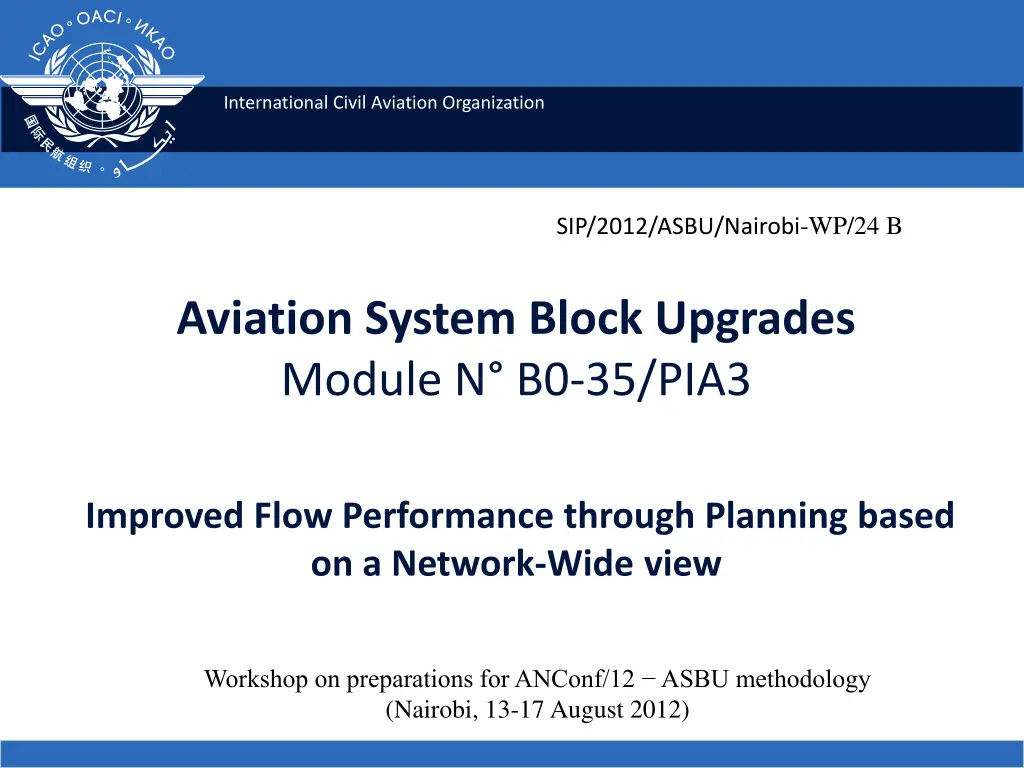
Improved Air Traffic Flow Performance - ASBU Methodology Overview
Learn about Module N.B0-35 focusing on improving air traffic flow performance through planning based on a network-wide view. Explore the impact on access, equity, capacity, efficiency, environment, and predictability with the use of Air Traffic Flow Management (ATFM) strategies. Discover the intended operational improvements and performance enhancements brought by this module for the aviation industry.
Download Presentation

Please find below an Image/Link to download the presentation.
The content on the website is provided AS IS for your information and personal use only. It may not be sold, licensed, or shared on other websites without obtaining consent from the author. If you encounter any issues during the download, it is possible that the publisher has removed the file from their server.
You are allowed to download the files provided on this website for personal or commercial use, subject to the condition that they are used lawfully. All files are the property of their respective owners.
The content on the website is provided AS IS for your information and personal use only. It may not be sold, licensed, or shared on other websites without obtaining consent from the author.
E N D
Presentation Transcript
International Civil Aviation Organization SIP/2012/ASBU/Nairobi-WP/24 B Aviation System Block Upgrades Module N B0-35/PIA3 Improved Flow Performance through Planning based on a Network-Wide view Workshop on preparations for ANConf/12 ASBU methodology (Nairobi, 13-17 August 2012)
Module N B0-35 Improved Flow Performance through Planning based on a Network-Wide view Summary Air Traffic Flow Management (ATFM) is used to manage the flow of traffic in a way that minimizes delay and maximizes the use of the entire national airspace. Main Performance Impact -KPA-01 Access & Equity - KPA-02 Capacity - KPA-04 Efficiency - KPA-05 Environment - KPA -09 Predictability Pre-flight phases, some action during actual flight. Region or sub-region DCB Demand-Capacity Balancing TS Traffic Synchronisation Operating Environment/Phases of Flight Applicability Considerations Global Concept Component(s) AOM Airspace Organisation and Management Global Plan Initiatives GPI-1 Flexible use of airspace GPI-6 Air traffic flow management GPI-8 Collaborative airspace design and management Global Readiness Checklist Status 2013 N/A Ready 2013 2013 Standards Readiness Avionics Availability Ground Systems Availability Procedures Available Operations Approvals ICAO SIP 2012- ASBU WORKSHOP 2
Module N B0-35 - Baseline It is difficult to describe an exact baseline. The need for ATFM emerges as traffic densities increased Even where overall capacity is not an issue, the efficient management of flows through a given volume of airspace deserves a specific consideration ICAO SIP 2012- ASBU WORKSHOP 3
Module N B0-35 Change Brought by the Module In order to regulate flows, ATFM may take measures of the following nature: Departure slots; Rate of entry; Requested time; Miles-in- trail figures; Re-routing; Sequencing of flights; Delaying of specific flights on the ground by a few minutes These measures are not mutually exclusive ICAO SIP 2012- ASBU WORKSHOP 4
Module N B0-35 Intended Performance Operational Improvement Access and Equity Improved access by avoiding disruption of air traffic in periods of demand higher than capacity; ATFM processes take care of equitable distribution of delays. Capacity Better utilisation of available capacity, network-wide; ability to anticipate difficult situations and mitigate them in advance. Reduced fuel burn due to better anticipation of flow issues; Efficiency Reduced block times and times with engines on. Reduced emissions as delays are absorbed on the ground, with shut engines; rerouting however generally put flight on a longer distance, but this is generally compensated by other airline operational benefits. Environment Participation by the ATM community Predictability Common understanding of operational constraints, capabilities and needs. Increased predictability of schedules as the ATFM algorithms tends to limit the number of large delays. Reduced occurrences of undesired sector overloads. The business case has proven to be positive due to the benefits that flights can obtain in terms of delay reduction. Safety CBA ICAO SIP 2012- ASBU WORKSHOP 5
Module N B0-35 Necessary Procedures (Air & Ground) An ICAO manual on ATFM is available in draft version and need to be completed and approved. US/Europe experience is enough to help initiate application in other regions. New procedures are required to link much closer the ATFM with ATS in the case of using miles-in-trail or Arrival management or Departure management ICAO SIP 2012- ASBU WORKSHOP 6
Module N B0-35 Necessary System Capability Avionics No avionics requirements Ground Systems When serving several FIRs, ATFM systems are generally deployed as a specific unit, system and software connected to the ATC units and airspace users to which it provides its services. Regional ATFM units have been the subject of specific developments. ICAO SIP 2012- ASBU WORKSHOP 7
Module N B0-35 Training and Qualification Requirements Flow managers in the flow management unit and controllers in ACCs need specific training and airline dispatchers using the remote flow management information or applications need training. Training in the operational standards and procedures are required for this module. Likewise, the qualifications requirements are identified in the regulatory requirements ICAO SIP 2012- ASBU WORKSHOP 8
Module N B0-35 Regulatory/standardization needs and Approval Plan (Air & Ground) Regulatory/Standardization: New standards and requirements is required for standard ATFM messages Approval Plans: To Be Determined. ICAO SIP 2012- ASBU WORKSHOP 9
Module N B0-35 Reference Documents Standards: TBD Procedures: TBD Guidance Material ICAO Global Collaborative Decision Making (CDM) including ATFM Guidelines (under development). Approval Documents ICAO Global Collaborative Decision Making (CDM) including ATFM Guidelines (under development). ICAO SIP 2012- ASBU WORKSHOP 10
Module N B0-35 Implementation - Benefits and Elements Improved Flow Performance through Planning based on a Network-Wide view Benefits - Main Key Performance Areas (KPA) Access Capacity Efficiency Environment Safety KPAs Applicable Y Y Y Y Y Element: - ATFM To be reflected in ANRF ICAO SIP 2012- ASBU WORKSHOP 11
